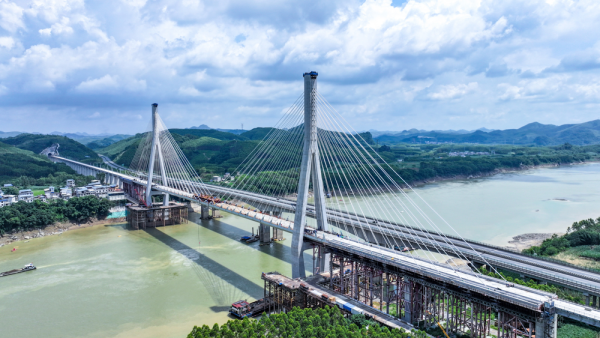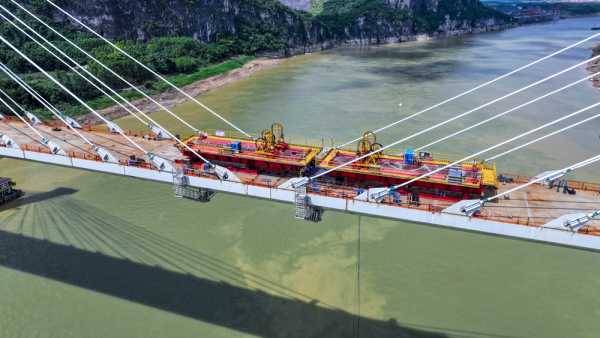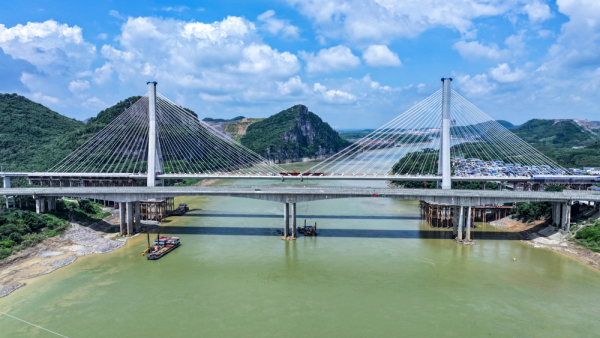The main deck of the Panlong Liujiang Grand Bridge, a crucial project of the Liuzhou–Wuzhou Railway, part of the Liuzhou–Guangzhou Railway, has recently achieved a significant milestone.

The main deck of the Panlong Liujiang Grand Bridge, a crucial project of the Liuzhou–Wuzhou Railway, part of the Liuzhou–Guangzhou Railway, has recently achieved a significant milestone. [Photo/sasac.gov.cn]
The main deck attained precise closure with millimeter-level accuracy upon the successful welding of the steel box girder closure segment. This achievement was realized by the skilled team at China Railway Major Bridge Engineering Group Co., Ltd., a subsidiary of China Railway Engineering Co., Ltd.

The bridge’s main deck attained precise closure with millimeter-level accuracy upon the successful welding of the steel box girder closure segment. [Photo/sasac.gov.cn]
Located in Laibin City, Guangxi Zhuang Autonomous Region, the whole bridge stretches across a total length of 3,787.42 meters. The main bridge spans 629 meters, with a main span of 326 meters. This architectural marvel is a double-pylon, double-plane cable-stayed bridge boasting a sturdy steel-concrete composite box girder structure.

Located in Laibin City, Guangxi Zhuang Autonomous Region, the bridge has a total length of 3,787.42 meters. [Photo/sasac.gov.cn]
The project team deployed “geological CT” scanning technology to thoroughly assess underground conditions. They innovatively applied a combined method of full-rotation casing and rotary drilling to precisely bore through complex rock layers, successfully avoiding risks such as water and sand inflows. Drilled pile foundations for the main piers were completed at a pace of one pile every seven days, setting a new construction speed record in Guangxi’s karst regions.
The two main pylons stand at 158 meters and 155 meters tall, respectively. Their cross-sections and inclination angles vary significantly, demanding extremely high precision in alignment control. The team introduced an intelligent climbing system integrated with an active horizontal bracing system for the middle tower sections. This setup enhanced structural rigor in real time, allowing the tower alignment error to be controlled within millimeter-level tolerances.
The bridge's main girder weighs approximately 7,200 tons and was assembled in 38 segments using a cantilever method over the river. Challenging conditions — including frequent strong winds and busy river traffic — posed significant assembly risks. To ensure safety and precision, smart radar and cameras were installed at critical points, with AI-powered systems used to analyze and prevent potential collisions. Sensors mounted on the steel box girders transmitted real-time data on stress and alignment to a centralized “cloud brain,” dynamically guiding the construction process and ultimately enabling the highly accurate closure.
The Liuzhou–Wuzhou Railway spans a total length of 238.167 kilometers and is designed as a dual-track, electrified line for both passenger and freight transport, with a target design speed of 160 km/h. Upon completion, the project will strengthen the regional integrated transportation network, expand transport channels for both passengers and goods, and play a key role in linking Sichuan, Chongqing, Yunnan, Guizhou, and central Guangxi to the Guangdong-Hong Kong-Macao Greater Bay Area.
(Executive editor: Yuan Ting)